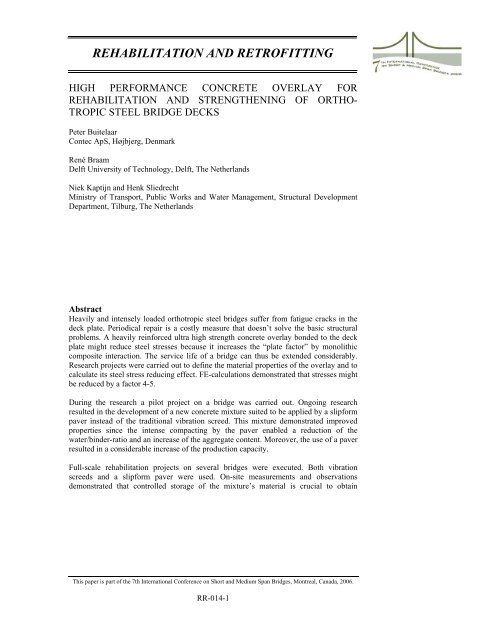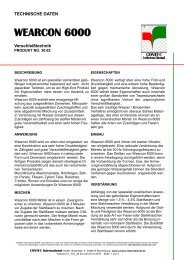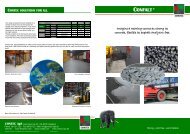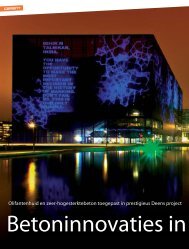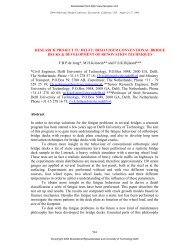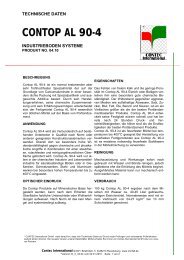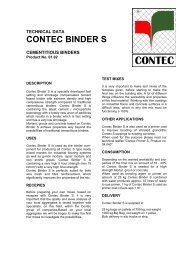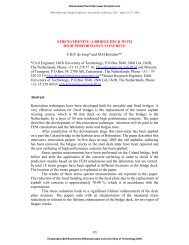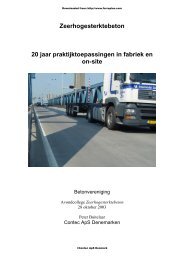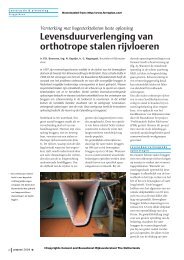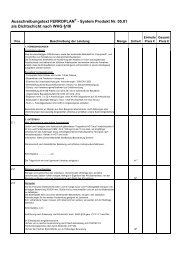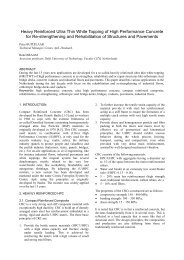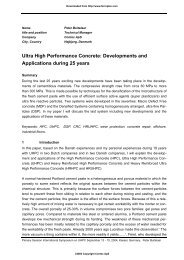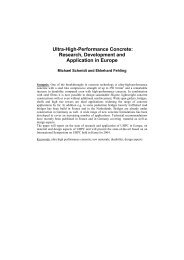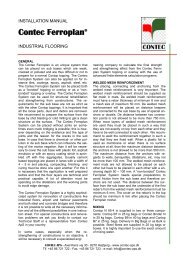High Performance Concrete Overlay for ... - CONTEC ApS
High Performance Concrete Overlay for ... - CONTEC ApS
High Performance Concrete Overlay for ... - CONTEC ApS
Create successful ePaper yourself
Turn your PDF publications into a flip-book with our unique Google optimized e-Paper software.
REHABILITATION AND RETROFITTING<br />
HIGH PERFORMANCE CONCRETE OVERLAY FOR<br />
REHABILITATION AND STRENGTHENING OF ORTHO-<br />
TROPIC STEEL BRIDGE DECKS<br />
Peter Buitelaar<br />
Contec <strong>ApS</strong>, Højbjerg, Denmark<br />
René Braam<br />
Delft University of Technology, Delft, The Netherlands<br />
Niek Kaptijn and Henk Sliedrecht<br />
Ministry of Transport, Public Works and Water Management, Structural Development<br />
Department, Tilburg, The Netherlands<br />
Abstract<br />
Heavily and intensely loaded orthotropic steel bridges suffer from fatigue cracks in the<br />
deck plate. Periodical repair is a costly measure that doesn’t solve the basic structural<br />
problems. A heavily rein<strong>for</strong>ced ultra high strength concrete overlay bonded to the deck<br />
plate might reduce steel stresses because it increases the “plate factor” by monolithic<br />
composite interaction. The service life of a bridge can thus be extended considerably.<br />
Research projects were carried out to define the material properties of the overlay and to<br />
calculate its steel stress reducing effect. FE-calculations demonstrated that stresses might<br />
be reduced by a factor 4-5.<br />
During the research a pilot project on a bridge was carried out. Ongoing research<br />
resulted in the development of a new concrete mixture suited to be applied by a slip<strong>for</strong>m<br />
paver instead of the traditional vibration screed. This mixture demonstrated improved<br />
properties since the intense compacting by the paver enabled a reduction of the<br />
water/binder-ratio and an increase of the aggregate content. Moreover, the use of a paver<br />
resulted in a considerable increase of the production capacity.<br />
Full-scale rehabilitation projects on several bridges were executed. Both vibration<br />
screeds and a slip<strong>for</strong>m paver were used. On-site measurements and observations<br />
demonstrated that controlled storage of the mixture’s material is crucial to obtain<br />
This paper is part of the 7th International Conference on Short and Medium Span Bridges, Montreal, Canada, 2006.<br />
RR-014-1
consistent fresh concrete properties. The demands with regard to the surface smoothness<br />
are difficult to be met when a vibration screed is used. However, this could partly be<br />
solved when applying an additional top layer to meet skid resistance demands. This top<br />
layer also seems to be required when a slip<strong>for</strong>m paver is used.<br />
1. Introduction<br />
<strong>High</strong> <strong>Per<strong>for</strong>mance</strong> <strong>Concrete</strong> (HPC, fc 100 – 150 MPa) and Ultra <strong>High</strong> <strong>Per<strong>for</strong>mance</strong><br />
<strong>Concrete</strong> (UHPC, fc 150 – >300 MPa) contain very densely packed cement and micro<br />
silica particles. Despite their (very) low water/ binder ratios, as originally developed by<br />
Hans Henrik Bache in 1978 and known under the acronym DSP, they have proven to be<br />
very useful when combined with large amounts of rein<strong>for</strong>cement [1-3]. The<br />
incorporation of large amounts of bar rein<strong>for</strong>cement and steel fibers, as based on the<br />
theories and discoveries of Hans Henrik Bache in 1986 (CRC, Compact Rein<strong>for</strong>ced<br />
Composite), results in a composite material with a high ductility, good fatigue resistance<br />
and high bending tensile strength [4-7]. This type of concrete is mainly used <strong>for</strong> heavily<br />
loaded structures or objects, such as [8,9]:<br />
• wear resistant components in hydraulic and pneumatic transport systems handling<br />
abrasive materials (fly ash, cement, silica sand, glass, etc.),<br />
• industrial floors and overlays in the heavy industry and food processing industry,<br />
• security industry components (vaults, ATM’s),<br />
• offshore structures (re-strengthening of plat<strong>for</strong>ms, offshore windmill foundations).<br />
Contec <strong>ApS</strong> redesigned the original DSP mortars to make them more efficiently<br />
applicable in industrial floors and ultra thin white toppings. Research was focused on the<br />
workability, finishability and shrinkage reduction (autogenous and chemical). This<br />
research resulted, among other things, in the development of the UTHRHPC overlay in<br />
which a HPC or an UHPC is combined with the CRC technology. This overlay,<br />
commercially marketed under the name Contec Ferroplan ® System, was during the last<br />
ten years used in several 100.000 m 2 of industrial floors, industrial pavements and ultra<br />
thin white toppings [10,11].<br />
2. Project “orthotropic steel bridge decks”<br />
After serious damage due to fatigue the bascule of the Van Brienenoord Bridge, a bridge<br />
in one of the main highways in The Netherlands, was replaced since cracks had occurred<br />
in the steel deck plate. A special Task Force was <strong>for</strong>med within the Civil Engineering<br />
Division of the Dutch Ministry of Transport, Public Works and Water Management. Its<br />
aims were to investigate the cause of the damage and to understand and control the<br />
fatigue mechanism of the total of 80 steel fixed and movable bridges in The Netherlands<br />
and to develop practical solutions <strong>for</strong> cost effective rehabilitation and renovation<br />
[12-14]. Various alternatives were experimentally investigated in cooperation with the<br />
Delft University of Technology and TNO Building and Construction Research. First,<br />
RR-014-2
esearch focused on re-strengthening of the deck plate. One of the alternatives<br />
investigated was to cast a steel fiber rein<strong>for</strong>ced HPC overlay. This was done earlier on a<br />
orthotropic bridge deck in Canada. Contec <strong>ApS</strong> was consulted because of their specific<br />
knowledge of HPC and UHPC overlays in which high amounts of bar rein<strong>for</strong>cement are<br />
applied. Different tests and calculations showed that an un-rein<strong>for</strong>ced HPC overlay will<br />
deteriorate very fast due to the high tensile stresses introduced by the traffic loads. This<br />
supported the idea to use an UTHRHPC overlay.<br />
3. Research<br />
During the period 1999 – 2005 the properties of a specific HPC and UTHRHPC overlay<br />
were investigated. These were required to design a rehabilitation technique and to<br />
develop new and check existing calculation methods. Furthermore, in<strong>for</strong>mation about<br />
the durability of the material and its behaviour under traffic loads were required to<br />
predict the extension of the service life [15,16]. Besides research on relatively small<br />
samples, also full-scale structural elements were tested under different loading<br />
conditions. Also FEM calculations and calculations on specific details were per<strong>for</strong>med<br />
[17]. The latter has to be per<strong>for</strong>med <strong>for</strong> each individual bridge project since the<br />
UTHRHPC overlay changes the properties of the orthotropic deck which will result in a<br />
relocation of stresses.<br />
Time-dependent de<strong>for</strong>mations of the UTHRHPC overlay caused by shrinkage are<br />
restrained by the steel bridge structure to which the concrete overlay is connected by<br />
means of an intermediate epoxy layer with sprinkled in aggregates. The tensile stresses<br />
introduced in the overlay might cause cracking of the concrete. Whereas reducing the<br />
water/binder ratio results in a reduction of the drying shrinkage it also results in an<br />
increase of another component of shrinkage, the so-called autogenous shrinkage [18,19].<br />
This shrinkage component is not found <strong>for</strong> normal strength traditional concretes since<br />
these have such a water-binder ratio (> 0.4), that there is always an overdose of water<br />
present. This overdose evaporates from the concrete when it is allowed to dry, causing<br />
the well-known ‘traditional’ (drying) shrinkage. HPC and UHPC, however, have a<br />
water-binder ratio that low, that there is less water present in the mixture than required to<br />
hydrate all binder material. During the hardening process the internal demand <strong>for</strong> water<br />
is higher than the amount of water available. This is called ‘internal’ drying and causes<br />
the concrete to shrink (‘autogenous shrinkage’), even when it is sealed to prevent<br />
evaporation. When placing the HRHPC overlay in a traditional way, i.e. with a vibration<br />
screed, only a limited area can be resurfaced within a certain period of time. This method<br />
also has its limits regarding the required consistency of the HPC. A much more stable<br />
HPC mix can be required since in most cases the bridge deck will be sloped and because<br />
vibrations can not be avoided since the bridge can not be closed completely <strong>for</strong> traffic.<br />
After the execution of a pilot project other placing methods were investigated. By using<br />
a slip<strong>for</strong>m paver it was possible to further reduce the water binder/ratio and to apply a<br />
higher percentage of “large” aggregates (2-4 mm). Even a “zero slump” HPC could be<br />
RR-014-3
applied because of the combined action of intense vibrating by high frequency poke<br />
vibrators and the pressure of the paver’s extrusion pan. A test area (300 m²) was placed<br />
with a large slip<strong>for</strong>m paver to test this placing method on a large scale. The speed of<br />
placing and the compressive strength development (70 MPa in less than 24 hours) and<br />
compacting of the material were very promising.<br />
In a test series is was investigated whether the higher amount of large aggregates and the<br />
lower amount of binder resulted in a reduction of autogenous shrinkage despite the<br />
reduction of the water/binder ratio. It was assumed that the very rigid “skeleton” of stiff<br />
aggregates and rein<strong>for</strong>cement is glued together by a thin layer of binder and silica sand<br />
such that shrinkage is hardly possible to occur. The shrinkage behaviour of three HPC<br />
mixtures were investigated: The standard when placing with a vibration screed<br />
(figure 1); a mixture specially designed <strong>for</strong> placing by slip<strong>for</strong>m paver (figure 2) and a<br />
standard <strong>for</strong> placing with vibration screed but including a so called internal curing<br />
compound which is premixed in the dry binder (figure 3).<br />
shrinkage de<strong>for</strong>mation [10 -3 ]<br />
0,45<br />
0,4<br />
0,35<br />
0,3<br />
0,25<br />
0,2<br />
0,15<br />
0,1<br />
0,05<br />
screeding beam mixture<br />
0<br />
0 7 14 21<br />
concrete age [d]<br />
28 35 42<br />
Figure 1: De<strong>for</strong>mation of the screeding beam mixture prisms.<br />
RR-014-4<br />
autogenous + drying<br />
autogenous - 3 d<br />
autogenous - 7 d<br />
autogenous<br />
The weight of the sealed prisms was also measured to check whether the sealing<br />
functioned correctly (e.g. no mass loss due to evaporation of water). The figures contain<br />
the results of the de<strong>for</strong>mation measurements. The shrinkage presented is the mean of six<br />
individual measurements (3 prisms, 2 measurements per prism). Shortening of the<br />
specimens is presented as a positive value. The horizontal axis presents the time elapsed<br />
since the moment of casting, i.e. the concrete age. When the measurements started all
prisms had an age of 1 day. The lines denoted as ‘autogenous – 3 d’ and ‘autogenous –<br />
7 d’ refer to originally sealed prisms of which the sealing was removed at an age of 3<br />
and 7 days, respectively. The prisms that remained sealed are denoted ‘autogenous’,<br />
whereas the prisms originally not sealed are called ‘autogenous + drying’ since they<br />
were subjected to both drying and autogenous shrinkage over the entire measuring<br />
period.<br />
The results presented in figure 2 demonstrate, as expected, that the highest shrinkage is<br />
found <strong>for</strong> the specimens that remained unsealed. The highest values observed <strong>for</strong> this<br />
combination of autogenous and drying shrinkage is 0.39‰ at an age of 28 d (registration<br />
period of 27 d) <strong>for</strong> the screeding beam mixture. The mixture with the lowest waterbinder<br />
ratio, being the slip<strong>for</strong>m paver mixture, demonstrated the lowest shrinkage,<br />
namely 0.33‰. The results <strong>for</strong> the screeding beam mixture with the internal curing was<br />
in between these two: 0.36‰. It must be noted that the slip<strong>for</strong>m paver mixture exhibits<br />
the lowest autogenous shrinkage, even though it has the lowest water-binder ratio:<br />
0.19‰ de<strong>for</strong>mation at 28 d of age. Also now, the screeding beam mixture has the<br />
highest shrinkage (0.26‰) and the result <strong>for</strong> the screeding beam mixture with internal<br />
curing is again in between the both mentioned be<strong>for</strong>e (0.22‰). If it is assumed that<br />
drying shrinkage is total shrinkage minus autogenous shrinkage, all three mixtures have<br />
an almost identical drying shrinkage, namely 0.13-0.14‰. Here it should be noted that a<br />
permanently sealed prism will exhibit a different autogenous shrinkage than a prism that<br />
is also subjected to drying: both have different internal moisture gradients which will<br />
affect internal processes that cause de<strong>for</strong>mations to occur.<br />
shrinkage de<strong>for</strong>mation [10 -3 ]<br />
0,45<br />
0,4<br />
0,35<br />
0,3<br />
0,25<br />
0,2<br />
0,15<br />
0,1<br />
0,05<br />
slip<strong>for</strong>m paver mixture<br />
0<br />
0 7 14 21<br />
concrete age [d]<br />
28 35 42<br />
Figure 2: De<strong>for</strong>mation of the slip<strong>for</strong>m paver mixture prisms.<br />
RR-014-5<br />
autogenous + drying<br />
autogenous - 3 d<br />
autogenous - 7 d<br />
autogenous
Figure 2 clearly demonstrates that the shrinkage accelerates if the sealing is removed.<br />
The de<strong>for</strong>mation of an unsealed prism is, however, an upper bound value that is not<br />
reached by the other prisms. The results from the weight measurements (not shown here)<br />
indicated that the sealing functioned well: continuously sealed prisms didn’t exhibit any<br />
mass loss.<br />
shrinkage de<strong>for</strong>mation [10 -3 ]<br />
0,45<br />
0,4<br />
0,35<br />
0,3<br />
0,25<br />
0,2<br />
0,15<br />
0,1<br />
0,05<br />
screeding beam mixture with internal curing<br />
0<br />
0 7 14 21<br />
concrete age [d]<br />
28 35 42<br />
4. Pilot project<br />
Figure 3: De<strong>for</strong>mation of the prisms from the screeding beam mixture<br />
with internal curing compound.<br />
RR-014-6<br />
autogenous + drying<br />
autogenous - 3 d<br />
autogenous - 7 d<br />
autogenous<br />
All the tests showed that the application of an UTHRHPC overlay is a very promising<br />
solution to rehabilitate orthotropic steel bridge decks and to extend the service life of the<br />
total structure. Both the durability and strength of the UTHRHPC overlay were proven<br />
to be adequate. There<strong>for</strong>e, in the period from April 29 th - May 4 th 2003 a pilot project<br />
was executed on the Caland bridge. It also aimed at testing the logistic aspects on a<br />
relatively small scale project be<strong>for</strong>e other more complex and much larger projects would<br />
be executed. The bridge area concerned were two traffic lanes with a total width of<br />
6.70 m and a length of 80 m in one traffic direction. During this period the entire project<br />
had to be executed, including re-routing the traffic, removal of the asphalt wearing<br />
course, inspection and repair of the deck plate and the application, finishing, hardening,<br />
curing and shot blasting of the UTHRHPC overlay [20,21]. All this was executed (from
the first step up to re-opening to traffic) within five days. The in<strong>for</strong>mation gathered was<br />
very useful <strong>for</strong> the larger projects executed in 2005 - 2006.<br />
Steel strain measurements on the re-surfaced Caland bridge demonstrated a reduction<br />
with a factor 4 - 5 in the fatigue critical structural details. This was in accordance with<br />
the reduction factors measured on small test samples and as derived from FEM computer<br />
simulations [22].<br />
5. Moerdijk and Hagestein bridges<br />
In May 2005 the first phase (direction Breda – Rotterdam, 2 times 2 driving lanes, each<br />
approx. 1,000 m long) ) of the rehabilitation of the largest orthotropic bridge in the<br />
Netherlands, the Moerdijk bridge, started [23]. The total area to resurface was<br />
32,000 m 2 . The Moerdijk bridge on the highway A16, is part of the mayor connection<br />
between the ports of Rotterdam in the Netherlands and Antwerp in Belgium. It is<br />
believed to have the most intense traffic spectrum of Western Europe. Rehabilitation was<br />
necessary since every 4 – 6 years fatigue cracks in the deck plate had to be repaired.<br />
These repairs have financial impact due to their high direct costs (welding several<br />
thousands of metres of cracks and applying a new asphalt wearing course) but also a<br />
high environmental impact because they create large streams of wasted materials and<br />
cause air pollution because of the large traffic jams caused by the closing of several<br />
lanes. The steel deck plate of the Moerdijk bridge is uneven. There<strong>for</strong>e, the overlay was<br />
applied in a varying thickness, ranging from 47 to 100 mm. The very dense<br />
rein<strong>for</strong>cement had to be positioned very accurately to provide a constant concrete cover<br />
of 20 – 25 mm on the rebars. Extra rein<strong>for</strong>cement was applied if the layer thickness was<br />
over 60 mm. Placing of the concrete was complicated since no transport was allowed on<br />
the mesh rein<strong>for</strong>cement. There<strong>for</strong>e, two transport lanes were used: one to transport the<br />
mixture from a nearby batching plant to the site by truck mixer, one to spread it using a<br />
small crane. In repeated cycles 20 parts each 100 m in length (from expansion joint to<br />
joint) were cast. All activities took place in a large tent to make them independent of the<br />
weather conditions.<br />
A total area of 4,200 m 2 (340 m long and approx. 12 m in width) on one of the two<br />
Hagestein bridges on the A27 (direction Breda – Almere) had to be resurfaced within a<br />
strict time schedule of maximum 14 days in July 2005. The overlay had a constant<br />
thickness of 60 mm, so the standard rebar mesh configuration of three layers of<br />
rein<strong>for</strong>cement of ø 8 mm could be used. This enabled transport of the mixture over the<br />
rein<strong>for</strong>cement after covering them with plywood plates in the driving route of the mixer<br />
trucks. The overlay was cast in two days, each casting being over the full width of the<br />
bridge. The original idea was to apply the overlay by using a slip<strong>for</strong>m paver but the use<br />
of the traditional vibration screed was found to be profitable <strong>for</strong> this relatively small job,<br />
Also here a large tent placed over the whole working area. As soon as the required<br />
concrete compressive strength of 50 MPa was reached (within 24 h after casting) the<br />
RR-014-7
idge was re-opened <strong>for</strong> traffic again. A special water spreading tube was positioned<br />
along the barrier to cure the overlay <strong>for</strong> 7 d without disturbing the traffic streams.<br />
6. Conclusions<br />
In the Moerdijk bridge project it was concluded that the contractor was not able to obtain<br />
the required smooth surface, which implied maximum vertical surface tolerances of<br />
3 mm over a measuring length of 3 m. Also the skid resistance was lower than expected.<br />
The complexity of the job (the bridge still in use, causing vibrations) in combination<br />
with the relatively new method of rehabilitation made placing and finishing more<br />
difficult than <strong>for</strong>eseen. A very thin wearing course on top of the RHPC might be<br />
required to obtain the required smoothness and surface skid resistance. Very fine<br />
transverse cracks (width 0.1 mm) are, as predicted, present each 0.2 – 0.3 m. The<br />
maximum crack depth is equal to the thickness of the concrete cover. In a small area of<br />
approximately 30 m 2 compaction was proven to be insufficient since some of the<br />
rein<strong>for</strong>cement at the bottom of the layer was not fully encapsulated by the concrete.<br />
Injecting was required to completely fill this area.<br />
Results from laboratory experiments per<strong>for</strong>med showed promising results <strong>for</strong> placing<br />
with a slip<strong>for</strong>m paver instead of a vibration screed. There<strong>for</strong>e, in 2005 an overlay was<br />
placed on the viaduct Voorst (A1/E30) in the Netherlands to re-strengthen the existing<br />
structure and to upgrade its capacity from 2 times 2 traffic lanes to 2 times 3 traffic<br />
lanes; a hard shoulder becoming a rush-hour lane. The overlay was here <strong>for</strong> the first time<br />
placed on an actual job with the use of a slip<strong>for</strong>m paver. Placing proved to be more<br />
efficient and the quality of the overlay increased.<br />
In all projects carried out special attention must be given to the storage of the aggregates<br />
used in the mixture. Already minor variations in their water content result in a<br />
considerable change in the consistency of the mixture. This might cause problems during<br />
placing, especially when the overlay is relatively thick, such as was the case at the<br />
Moerdijk bridge, and when the overlay is placed using a slip<strong>for</strong>m paver.<br />
Despite several problems, partly related to the lack of experience at all parties involved,<br />
there is great interest in continuing the re-strengthening of orthotropic steel bridge decks<br />
in the near future. Even when it is necessary to afterwards place a thin wearing course on<br />
top of the UTHRHPC overlay to cope with skid resistance and smoothness problems<br />
[24], it is up to now the most promising method available. Steel stresses in the fatigue<br />
critical structural details of the orthotropic steel bridge deck might be reduced with a<br />
factor of 4 – 5. Other countries facing similar fatigue problems have shown their interest<br />
in the rehabilitation method developed in a unique cooperation between the civil<br />
engineering division of the Ministry of Transport, a technical university, the supplier of<br />
the UTHRHPC overlay and contractors.<br />
RR-014-8
New applications <strong>for</strong> the UTHRHPC in combination with a “back plate” consisting of<br />
various materials will be developed in the near future to re-strength offshore plat<strong>for</strong>ms,<br />
supply vessels and dry docks.<br />
7. References<br />
1. Bache, H.H. Densified cement / ultra fine particle based materials. The second<br />
International conference on superplasticizers in <strong>Concrete</strong>. Ottawa, Ontario, Canada<br />
June 10 – 12, 1981.<br />
2. Buitelaar, P. Densit high per<strong>for</strong>mance concretes <strong>for</strong> very strong and dense concrete<br />
(in Dutch). Cement 1992 no. 11.<br />
3. Buitelaar, P. Ultra <strong>High</strong> Strength <strong>Concrete</strong>, Congresso del Concreto 1995,<br />
AVICOPRE, Caracas Venezuela.<br />
4. Bache, H.H. Compact Rein<strong>for</strong>ced Composite. CBL Report no. 39. Cement and<br />
<strong>Concrete</strong> laboratory Aalborg Portland.<br />
5. Bache, H.H. Compact Rein<strong>for</strong>ced Composite Basic Principles. CBL Report No. 41.<br />
Cement- and <strong>Concrete</strong> lab. Aalborg Portland. May 1987.<br />
6. Kaptijn, N. A new bridge deck <strong>for</strong> the Kaag bridges. International Symposium on<br />
Ultra <strong>High</strong> <strong>Per<strong>for</strong>mance</strong> <strong>Concrete</strong>. Kassel, September 2004.<br />
7. Buitelaar, P. Heavy Rein<strong>for</strong>ced Ultra <strong>High</strong> <strong>Per<strong>for</strong>mance</strong> <strong>Concrete</strong>. International<br />
Symposium on Ultra <strong>High</strong> <strong>Per<strong>for</strong>mance</strong> <strong>Concrete</strong>. Kassel, September 2004.<br />
8. Bache, H.H. New <strong>Concrete</strong> – New Technology (in Danish). Beton – Teknik<br />
08.04.92 CtO Aalborg Portland.<br />
9. Buitelaar, P. Ultra <strong>High</strong> <strong>Per<strong>for</strong>mance</strong> <strong>Concrete</strong>: Developments and Applications<br />
during 25 years. Plenary session International Symposium on Ultra <strong>High</strong><br />
<strong>Per<strong>for</strong>mance</strong> <strong>Concrete</strong>. Kassel, September 2004.<br />
10. Buitelaar P. Ultra thin white toppings using high strength high per<strong>for</strong>mance<br />
concretes (in Dutch). Cement 1999 nr. 7.<br />
11. Buitelaar, P., 2002. Ultra Thin Heavy Rein<strong>for</strong>ced <strong>High</strong> <strong>Per<strong>for</strong>mance</strong> <strong>Concrete</strong><br />
<strong>Overlay</strong>s. 6th International Symposium on Utilization of <strong>High</strong> Strength / <strong>High</strong><br />
<strong>Per<strong>for</strong>mance</strong> <strong>Concrete</strong>, Leipzig, Germany.<br />
12. Boersma, P.D., de Jong, F.B.P. 2003. Techniques and solutions <strong>for</strong> rehabilitation of<br />
orthotropic steel bridge decks in the Netherlands. Proceedings Structural Faults and<br />
Repair. United Kingdom 2003.<br />
13. Boersma, P.D., Kaptijn, N. and Nagtegaal, G. Increasing the lifespan of orthotropic<br />
steel bridge decks. (in Dutch). Cement 2004 no. 4<br />
14. De Jong F.B.P.,Boersma P.D. 2003. Lifetime calculations <strong>for</strong> Orthotropic steel<br />
bridge decks. Proceedings Structural Faults and Repair. United Kingdom 2003.<br />
15. Braam, C.R., Kaptijn, N., Buitelaar, P., 2003. HPC as bridge deck overlay.<br />
Technological, structural and durability aspects. (in Dutch). Cement 2003 no.1.<br />
16. Braam, C.R. et al. Research Contec Ferroplan System 2002 - 2005. Research reports<br />
Stevinlaboratory, Delft University of Technology.<br />
RR-014-9
17. Pover, J., 2002. Draft Internal report Ministry of Transport; Analyses of various<br />
solutions <strong>for</strong> life time extension - PSR-project (in Dutch). April 2002.<br />
18. Koenders, E.A.B. Simulation of volume changes in hardening cement-based<br />
materials. Dissertation, Delft University of Technology, 1997.<br />
19. Lokhorst, S.J. De<strong>for</strong>mational behaviour of concrete influenced by hydration related<br />
changes of the microstructure. Faculty of Civil Engineering and Geosciences, Delft<br />
University of Technology, report 25.5-99-05, 2001<br />
20. Buitelaar, P., Kaptijn, N., Braam, C.R. 2004. Rein<strong>for</strong>ced high per<strong>for</strong>mance concrete<br />
overlay system <strong>for</strong> steel bridges. 5 th. CROW workshop Istanbul, Turkey.<br />
21. Buitelaar, P., Braam, C.R., Kaptijn, N. 2004. Rein<strong>for</strong>ced <strong>High</strong> <strong>Per<strong>for</strong>mance</strong><br />
<strong>Concrete</strong> <strong>Overlay</strong> System <strong>for</strong> Rehabilitation and Strengthening of Orthotropic Steel<br />
bridge decks. Proceedings ASCE/ SEI Orthotropic Bridge Conference. Sacramento,<br />
CA. USA 2004.<br />
22. De Jong, F.B.P., Kolstein, M.H. Strengthening a bridge deck with high concrete.<br />
Proceedings ASCE/ SEI. Orthotropic Bridge Conference. Sacramento, CA. USA<br />
2004.<br />
23. Buitelaar, P., Braam, C.R., Kaptijn, N. 2005. <strong>Concrete</strong> evidence. Bridge design &<br />
engineering Issue No. 40 Third Quarter 2005. United Kingdom.<br />
24. Sedlacek, G. and Paschen, M. Proceedings Experts meeting: Maintenance of<br />
orthotropic steel bridge decks. German Federal <strong>High</strong>way Research Institute (Bast)<br />
19 October 2005. Bergisch Gladbach, Germany.<br />
RR-014-10


